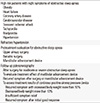Abstract
Obstructive sleep apnea is a prevalent disease and contributes to consequences like hypertension, diabetes, stroke, cardiac disease, daytime sleepiness, decreased productivity, mood change, and quality of life. The mortality and morbidity due to consequences are related to severity of obstructive sleep apnea. The severity of obstructive sleep apnea is measured by apnea-hypopnea index or respiratory disturbance index. The diagnosis of obstructive sleep apnea is made by polysomnographic findings and/or one of its symptoms (daytime symptoms like unintentional sleep episode during wakefulness, daytime sleepiness, unrefreshing sleep, insomnia, or fatigue, nighttime symptoms like breath holding, gasping, or choking, or bed partner's report about loud snoring, breath stopping). Due to high cost, inconvenience, and availability of in-lab polysomnogrpahy, simple diagnostic tools are suggested. Portable polysomnography has advantages including low cost, home monitoring, and convenience. But portable polysomnography has limitations like safety issues, lead malfunction, sensitivity, and specificity. Moreover, in some patients, portable polysomnography cannot be applied. The standard suggested diagnostic methods and available alternative tools are reviewed.
References
1. Epstein LJ, Kristo D, Strollo PJ Jr, Friedman N, Malhotra A, Patil SP, et al. Clinical guideline for the evaluation, management and long-term care of obstructive sleep apnea in adults. J Clin Sleep Med. 2009; 5:263–276.
2. Kim J, In K, You S, Kang K, Shim J, Lee S, et al. Prevalence of sleep-disordered breathing in middle-aged Korean men and women. Am J Respir Crit Care Med. 2004; 170:1108–1113.

3. Hung J, Whitford EG, Parsons RW, Hillman DR. Association of sleep apnoea with myocardial infarction in men. Lancet. 1990; 336:261–264.

4. Shahar E, Whitney CW, Redline S, Lee ET, Newman AB, Nieto FJ, et al. Sleep-disordered breathing and cardiovascular disease: cross-sectional results of the Sleep Heart Health Study. Am J Respir Crit Care Med. 2001; 163:19–25.

6. Verstraeten E. Neurocognitive effects of obstructive sleep apnea syndrome. Curr Neurol Neurosci Rep. 2007; 7:161–166.

7. Horstmann S, Hess CW, Bassetti C, Gugger M, Mathis J. Sleepiness-related accidents in sleep apnea patients. Sleep. 2000; 23:383–389.

8. Krakow B, Melendrez D, Ferreira E, Clark J, Warner TD, Sisley B, et al. Prevalence of insomnia symptoms in patients with sleep-disordered breathing. Chest. 2001; 120:1923–1929.

9. Pedrosa RP, Drager LF, Gonzaga CC, Sousa MG, de Paula LK, Amaro AC, et al. Obstructive sleep apnea: the most common secondary cause of hypertension associated with resistant hypertension. Hypertension. 2011; 58:811–817.
10. Tasali E, Mokhlesi B, Van Cauter E. Obstructive sleep apnea and type 2 diabetes: interacting epidemics. Chest. 2008; 133:496–506.
11. Chen YH, Keller JK, Kang JH, Hsieh HJ, Lin HC. Obstructive sleep apnea and the subsequent risk of depressive disorder: a population-based follow-up study. J Clin Sleep Med. 2013; 9:417–423.

12. Nena E, Papanas N, Steiropoulos P. Undetected obstructive sleep apnoea (OSA) in the workforce and reduced work productivity in OSA: We need to improve screening to see the whole picture. Chron Respir Dis. 2013; 10:183.

13. Goncalves MA, Guilleminault C, Ramos E, Palha A, Paiva T. Erectile dysfunction, obstructive sleep apnea syndrome and nasal CPAP treatment. Sleep Med. 2005; 6:333–339.

14. Bulcun E, Ekici A, Ekici M. Quality of life and metabolic disorders in patients with obstructive sleep apnea. Clin Invest Med. 2012; 35:E105–E113.

15. Chang JL, Kezirian EJ. What are the health risks of untreated snoring without obstructive sleep apnea? Laryngoscope. 2013; 123:1321–1322.

16. Douglas NJ. ABC of sleep disorders. The sleep apnoea/hypopnoea syndrome and snoring. BMJ. 1993; 306:1057–1060.

17. Marin JM, Carrizo SJ, Vicente E, Agusti AG. Long-term cardiovascular outcomes in men with obstructive sleep apnoea-hypopnoea with or without treatment with continuous positive airway pressure: an observational study. Lancet. 2005; 365:1046–1053.

18. American Academy of Sleep Medicine. The International classification of sleep disorders: diagnostic and coding manual. 2nd ed. Westchester, IL: American Academy of Sleep Medicine;2005.
19. Iber C, Ancoli-Israel S, Chesson A, Quan SF. The AASM manual for the scoring of sleep and associated events: rules, terminology and technical specifications. 1st ed. Westchester, IL: American Academy of Sleep Medicine;2007.
20. Berry RB, Budhiraja R, Gottlieb DJ, Gozal D, Iber C, Kapur VK, et al. Deliberations of the Sleep Apnea Definitions Task Force of the American Academy of Sleep Medicine. Rules for scoring respiratory events in sleep: update of the 2007 AASM Manual for the Scoring of Sleep and Associated Events. J Clin Sleep Med. 2012; 8:597–619.

21. Sleep-related breathing disorders in adults: recommendations for syndrome definition and measurement techniques in clinical research. The Report of an American Academy of Sleep Medicine Task Force. Sleep. 1999; 22:667–689.
22. Johns MW. Daytime sleepiness, snoring, and obstructive sleep apnea. The Epworth Sleepiness Scale. Chest. 1993; 103:30–36.

23. Kong HW, Lee HJ, Choi YS, Rha JH, Ha CK, Hwang DU, et al. Clinical predictors of obstructive sleep apnea. J Korean Neurol Assoc. 2005; 23:324–329.
24. Kushida CA, Littner MR, Morgenthaler T, Alessi CA, Bailey D, Coleman J Jr, et al. Practice parameters for the indications for polysomnography and related procedures: an update for 2005. Sleep. 2005; 28:499–521.

25. Collop NA, Anderson WM, Boehlecke B, Claman D, Goldberg R, Gottlieb DJ, et al. Clinical guidelines for the use of unattended portable monitors in the diagnosis of obstructive sleep apnea in adult patients. Portable Monitoring Task Force of the American Academy of Sleep Medicine. J Clin Sleep Med. 2007; 3:737–747.




 PDF
PDF ePub
ePub Citation
Citation Print
Print



 XML Download
XML Download